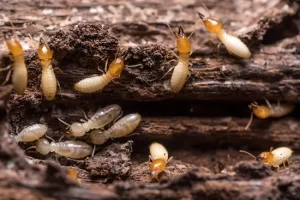Termites

Termites are generally grouped according to their feeding behavior. Thus, the commonly used general groupings are subterranean, soil-feeding, drywood, dampwood, and grass-eating. Of these, subterraneans and drywoods are primarily responsible for damage to human-made structures.
All termites eat cellulose in its various forms as plant fiber. Cellulose is a rich energy source (as demonstrated by the amount of energy released when wood is burned), but remains difficult to digest.
Termites rely primarily upon symbiotic protozoa (metamonads) such as Trichonympha, and other microbes in their gut to digest the cellulose for them and absorb the end products for their own use. Gut protozoa, such as Trichonympha, in turn rely on symbiotic bacteria embedded on their surfaces to produce some of the necessary digestive enzymes. This relationship is one of the finest examples of mutualism among animals. Most so called “higher termites”, especially in the Family Termitidae, can produce their own cellulase enzymes. However, they still retain a rich gut fauna and primarily rely upon the bacteria. Due to closely related bacterial species, it is strongly presumed that the termites’ gut flora are descended from the gut flora of the ancestral wood-eating cockroaches, like those of the genus
Cryptocercus.
Some species of termite practice fungiculture. They maintain a ‘garden’ of specialized fungi of genus Termitomyces, which are nourished by the excrement of the insects. When the fungi are eaten, their spores pass undamaged through the intestines of the termites to complete the cycle by germinating in the fresh faecal pellets. They are also well known for eating smaller insects in a last resort environment.
Timber damage
Due to their wood-eating habits, many termite species can do great damage to unprotected buildings and other wooden structures. Their habit of remaining concealed often results in their presence being undetected until the timbers are severely damaged and exhibit surface changes. Once termites have entered a building, they do not limit themselves to wood; they also damage paper, cloth, carpets, and other cellulosic materials. Particles taken from soft plastics, plaster, rubber, and sealants such as silicone rubber and acrylics are often employed in construction.
Humans have moved many wood-eating species between continents, but have also caused drastic population decline in others through habitat loss and pesticide application.
Precautions:
Avoid contact of susceptible timber with ground by using termite-resistant concrete, steel, or masonry foundation with appropriate barriers. Even so, termites are able to bridge these with shelter tubes, and it has been known for termites to chew through piping made of soft plastics and even some metals, such as lead, to exploit moisture. In general, new buildings should be constructed with embedded physical termite barriers so that there are no easy means for termites to gain concealed entry. While barriers of poisoned soil, so called termite pre-treatment, have been in general use since the 1970s, it is preferable that these be used only for existing buildings without effective physical barriers.
The intent of termite barriers (whether physical, poisoned soil, or some of the new poisoned plastics) is to prevent the termites from gaining unseen access to structures. In most instances, termites attempting to enter a barriered building will be forced into the less favourable approach of building shelter tubes up the outside walls, and thus, they can be clearly visible both to the building occupants and a range of predators.
Timber treatment
Use of timber that is naturally resistant to termites such as Syncarpia glomulifera (Turpentine Tree), Callitris glaucophylla (White Cypress), or one of the Sequoias. Note that there is no tree species whose every individual tree yields only timbers that are immune to termite damage, so that even with well known termite-resistant timber types, there will occasionally be pieces that are attacked. No species of tree produces timber that is completely immune to damage from every species of termite, some individual pieces of wood may be attacked.
When termites have already penetrated a building, the first action is usually to destroy the colony with insecticides before removing the termites’ means of access and fixing the problems that encouraged them in the first place. Baits (feeder stations) with small quantities of disruptive insect hormones or other very slow acting toxins have become the preferred least-toxic management tool in most western countries. This has replaced the dusting of toxins direct into termite tunnels that had been widely done since the early 1930s (originating in Australia). The main dust toxicants have been the inorganic metallic poison arsenic trioxide, insect growth regulators (hormones) such as triflumuron and, more recently fipronil, a phenyl-pyrazole. Blowing dusts into termite workings is a highly skilled process. All these slow-acting poisons can be distributed by the workers for hours or weeks before any symptoms occur and are capable of destroying the entire colony. More modern variations include chlorfluazuron, diflubenzuron, hexaflumuron, and novaflumuron as bait toxicants and fipronil and imidacloprid as soil poisons. Soil poisons are the least-preferred method of control as this requires much larger doses of toxin and results in uncontrollable release to the environment.The termite’s effects are damaging, costing the southwestern United States approximately $1.5 billion each year in wood structure damage

